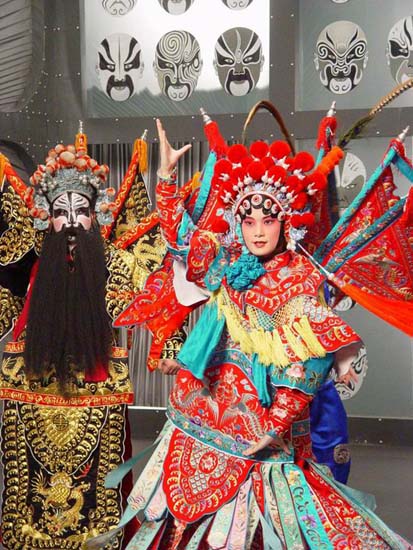戏曲
Chinese Opera

原文:
Chinese Opera is the traditional form of Chinese theatre, which combines dialogue, music, vocal performance, dance, kung fu(gong fu), acrobatics, and so on. It is one of the three oldest theatrical art forms in the world, together with Greek Theatre and Indian Sanskrit Opera. The origin of it can be traced back to the singing and dancing and religious rituals in primitive times. But not until the late Song Dynasty (960-1279 A.D.) and the early Yuan Dynasty (1279-1368 A.D.) through a very long period of development and reforms did Chinese Opera form a mature and complete artistic system. According to partial statistics, there are over 360 regional opera styles in China, among which, Kunqu Opera is one of the oldest extant forms of Chinese Opera.
Kunqu Opera, which evolved from the Kunshan melody in the Yuan Dynasty, boasts a 600-year history. Renowned for its gentle and clear vocals, beautiful and refined tunes, it gradually spread from Kunshan region nearby Suzhou to the rest of China and dominated Chinese theatre from the 16th to the 18th centuries, widely popular among gentry and common people. Kunqu is known as the "mother" of a hundred operas, because of its influence on other Chinese theatre forms, including Beijing opera. In 2001, Kunqu was listed as one of the Masterpieces of the Oral and Intangible Heritage of Humanity by UNESCO.
Nearly disappeared by the early 20th century, Kunqu now is thriving again. Plays that continue to be famous today include The Peony Pavilion by the most gifted playwright of the Ming Dynasty, Tang Xianzu, the contemporary of William Shakespeare, Fifteen Strings of Copper Coins, by Zhu Suchen, The Peach Blossom Fan by Kong Shangren, The Palace of Eternal Youth by Hong Sheng. In addition, many classical scenes from other extinct pieces have survived.
Among the hundreds of forms of opera throughout China, Beijing Opera has the greatest influence and is therefore regarded as a national opera. The roles in Beijing Opera are divided into four main types according to the sex, age, social status, and profession of the character: Sheng (male roles), Dan (female roles), Jing (roles with painted faces) and Chou (clowns) and besides, there are some other minor types.
Symbolism prevails in Beijing Opera, the stage of which knows no limit in space or time. The music of Beijing Opera mainly combines the Er Huang tune, the Xi Pi tune, and melodies of Kunqu. Typical Chinese musical instruments are used in a Beijing Opera orchestra, such as Jing Hu (two-string fiddle), Pi Pa (Chinese lute), Sheng (reed pipes), drums and gongs, etc.
Facial painting is a prominent feature of Beijing Opera. It shows the character's age, profession and personality by using different patterns and colors. Each color symbolizes a certain characteristic; red for loyalty and uprightness; black for a rough, stern or honest nature; yellow for rashness and fierceness; white for cunningness and deceitfulness; purple for bravery and wisdom; blue for a daring and vigorous character; gold and silver for gods and demons.












